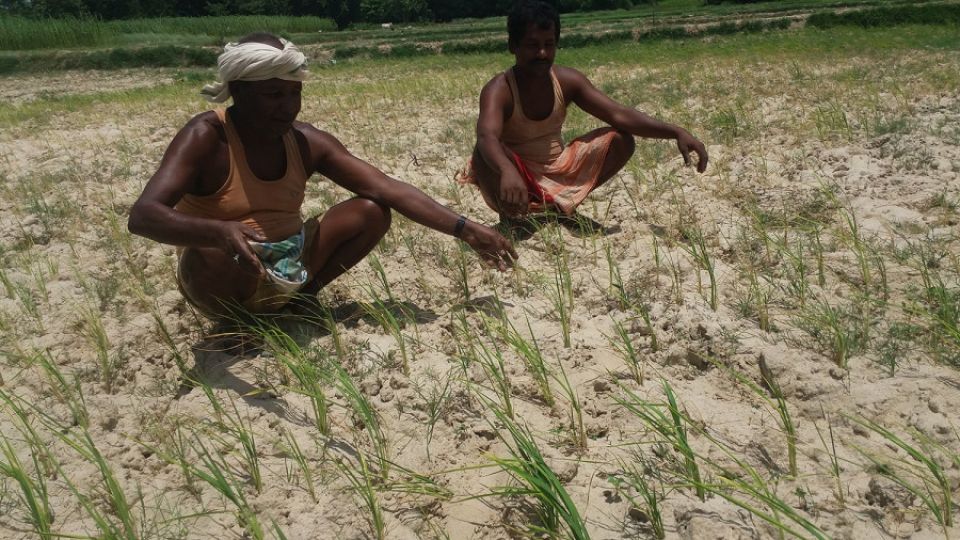August 17, 2022
KATHMANDU – Kalpana Sharma, a local from Narainapur Rural Municipality-4 of Banke district, has stopped hoping for rainfall. All the crops in her field have dried up. She has sold her goats, and one of her sons is in India looking for work as district authorities declare Narainapur Rural Municipality a drought-hit zone.
“Clouds gather in the sky, but no rain falls. Only strong wind blows,” Sharma told the Post over the phone. “We don’t have anything to eat. We are all preparing to go to India in search of work.”
Narainapur, a remote municipality in the midwestern region, was one of the worst hit areas when the pandemic gripped the country in the spring of 2020. Last year, the freak rain post-monsoon inundated farmlands covering 3,966 hectares. And this year, an ongoing dry spell is displacing people.
Like most farmers in Nepal, farmers in Narainapur depend heavily on rainfall for agriculture in the lack of an irrigation system. And water use is excessive in rice cultivation. An extended dry spell in the areas this year has brutally cracked large swathes of agricultural land, wilting all crops.
“We had planted paddy in 15 bigha (3.76 hectares) of land using borewell water in hopes of a good monsoon but the paddy saplings turned to straw in the field,” said Safiullah Khan, another local from Narainapur-4. “Currently, we are contemplating where to go in search of work for survival.”
Khan’s two elder brothers left for India a few days ago in search of work, while the rest of their 28-member large family are also preparing to follow suit as it remains their only option to break bread.
“Adults in Narainapur have been leaving the village and going to India in search of work, as they don’t have any work left in the village,” said Laxmi Kanta Mishra, ward secretary and information officer at the rural municipality. “Many have already left and more people plan to migrate.”
Nepal has been at the receiving end of the climate crisis.
If an ongoing dry spell in the mid-western district is forcing hundreds in Narainapur to cross the border in search of livelihood opportunities, a recent flash flood in the Koshi basin caused by short-duration extreme rainfall following a dry spell has displaced hundreds in the eastern region.
In Narainapur, officials are yet to come to terms with the loss in the wake of the dry spell. According to officials, some 200 hectares of agricultural land in wards 5 and 6 have cracked and wilted paddy saplings.
“We have not yet figured out the loss in monetary value,” said Sadan Bhandari, chief of the Agriculture Section at the Rural Municipality. “Had the crops yielded, it would have been easy to figure out the monetary value but we know that all the crop plants and saplings have dried up in the fields.”
In eastern Nepal, where over 400 people were displaced by the Koshi flood some two weeks ago, officials are yet to assess the damage. According to Dijan Bhattarai, spokesperson for the National Disaster Risk Reduction and Management Authority, it could take months.
Across the country, at least 38 people have died, and 5,398 people have been displaced in the ongoing monsoon. Official data also show 113 houses were destroyed and 65 partially damaged due to flood and landslide.
Landslides are also an increasing threat across the hill belt. At the same time, dry spells and prolonged drought have become the next big worry for Nepal’s food security after the fertiliser crisis, but experts say the apathy of the authorities is a bigger threat.
“We have been discussing climate change and its possible impacts for over a decade,” said Madhukar Upadhya, a climate change expert. “The impacts have become more visible but authorities are not prepared to deal with it.”
Scores of studies and scientific analyses over the decade, and more recently, the IPCC report, have warned that Nepal is one of the most vulnerable countries and it cannot be business-as-usual to tackle the adverse impacts of the climate crisis.
As climate disasters fueled by erratic weather patterns become more pronounced and frequent, experts say another crisis has been in the making over the years—climate displacement, both internal and external.
“From the adaptation and mitigation stage, we have already reached the loss and damage stage,” said Raju Pandit Chhetri, director of Prakriti Resources Centre, which advocates for environment-friendly policies and development practices. “Those highly affected and displaced should be provided immediate relief and authorities should implement the policies it has made to deal with the effects of climate change.”
Back in Narainapur, which has been formally declared a drought-hit zone, an understanding has been reached to give up to 80 percent relief in land revenue tax to the affected farmers, according to Mishra.
“Provincial and federal governments can also announce relief to the drought-hit farmers,” he said.
But mistrust of the government is rife as hundreds and more prepare to cross the border in search of work amid extreme weather.
“Relief was announced last year too when our fields were inundated but we didn’t get a single penny,” Khan, the farmer, said. “I don’t think it will be any different this time.”


